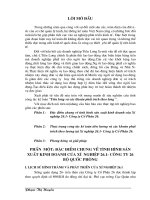26 security2 140505211728 phpapp01
Bạn đang xem bản rút gọn của tài liệu. Xem và tải ngay bản đầy đủ của tài liệu tại đây (426.04 KB, 47 trang )
Introduction to
Network Security
Guest Lecture
Debabrata Dash
Outline
•
•
•
•
Security Vulnerabilities
DoS and D-DoS
Firewalls
Intrusion Detection Systems
Security Vulnerabilities
• Security Problems in the TCP/IP Protocol
Suite – Steve Bellovin - 89
• Attacks on Different Layers
– IP Attacks
– ICMP Attacks
– Routing Attacks
– TCP Attacks
– Application Layer Attacks
Why?
• TCP/IP was designed for connectivity
– Assumed to have lots of trust
• Host implementation vulnerabilities
– Software “had/have/will have” bugs
– Some elements in the specification were left
to the implementers
Security Flaws in IP
• The IP addresses are filled in by the originating host
– Address spoofing
• Using source address for authentication
– r-utilities (rlogin, rsh, rhosts etc..)
•Can A claim it is B to the
server S?
2.1.1.1 C
•ARP Spoofing
Internet
Internet
•Can C claim it is B to the
server S?
1.1.1.3 S
•Source Routing
A
1.1.1.1
1.1.1.2
B
Security Flaws in IP
• IP fragmentation attack
– End hosts need to keep the fragments till all the
fragments arrive
• Traffic amplification attack
– IP allows broadcast destination
– Problems?
Ping Flood
Internet
Internet
Attacking System
Broadcast
Broadcast
Enabled
Enabled
Network
Network
Victim System
ICMP Attacks
• No authentication
• ICMP redirect message
– Can cause the host to switch gateways
– Benefit of doing this?
• Man in the middle attack, sniffing
• ICMP destination unreachable
– Can cause the host to drop connection
• ICMP echo request/reply
• Many more…
– />
Routing Attacks
• Distance Vector Routing
– Announce 0 distance to all other nodes
• Blackhole traffic
• Eavesdrop
• Link State Routing
– Can drop links randomly
– Can claim direct link to any other routers
– A bit harder to attack than DV
• BGP
– ASes can announce arbitrary prefix
– ASes can alter path
TCP Attacks
SYN x
SYN y | ACK x+1
Client
ACK y+1
Server
Issues?
– Server needs to keep waiting for ACK y+1
– Server recognizes Client based on IP address/port
and y+1
TCP Layer Attacks
• TCP SYN Flooding
– Exploit state allocated at server after initial
SYN packet
– Send a SYN and don’t reply with ACK
– Server will wait for 511 seconds for ACK
– Finite queue size for incomplete connections
(1024)
– Once the queue is full it doesn’t accept
requests
TCP Layer Attacks
• TCP Session Hijack
– When is a TCP packet valid?
• Address/Port/Sequence Number in window
– How to get sequence number?
• Sniff traffic
• Guess it
– Many earlier systems had predictable ISN
– Inject arbitrary data to the connection
TCP Layer Attacks
• TCP Session Poisoning
– Send RST packet
• Will tear down connection
– Do you have to guess the exact sequence
number?
• Anywhere in window is fine
• For 64k window it takes 64k packets to reset
• About 15 seconds for a T1
Application Layer Attacks
• Applications don’t authenticate properly
• Authentication information in clear
– FTP, Telnet, POP
• DNS insecurity
– DNS poisoning
– DNS zone transfer
An Example
Shimomura (S)
Finger
Showmount -e
SYN
Trusted (T)
• Finger @S
• Attack when no one is around
• showmount –e
• What other systems it trusts?
• Send 20 SYN packets to S
Mitnick
• Determine ISN behavior
An Example
Shimomura (S)
Syn flood
X
Trusted(T)
• Finger @S
• Attack when no one is around
• showmount –e
• What other systems it trusts?
• Send 20 SYN packets to S
• SYN flood T
Mitnick
• Determine ISN behavior
• T won’t respond to packets
An Example
SYN|ACK
Shimomura (S)
ACK
SYN
X
trusted (T)
• Finger @S
• Attack when no one is around
• showmount –e
• What other systems it trusts?
• Send 20 SYN packets to S
Mitnick (M)
• Determine ISN behavior
• SYN flood T
• T won’t respond to packets
• Send SYN to S spoofing as T
• S assumes that it has a session
with T
• Send ACK to S with a
guessed number
An Example
Shimomura (S)
X
++ > rhosts
Trusted (T)
• Finger @S
• Attack when no one is around
• showmount –e
• What other systems it trusts?
• Send 20 SYN packets to S
Mitnick
• Determine ISN behavior
• SYN flood T
• T won’t respond to packets
• Send SYN to S spoofing as T
• S assumes that it has a session
with T
• Send ACK to S with a
guessed number
• Send “echo + + > ~/.rhosts”
• Give permission to anyone from
anywhere
Outline
•
•
•
•
Security Vulnerabilities
DoS and D-DoS
Firewalls
Intrusion Detection Systems
You are here
Denial of Service
• Objective make a service unusable, usually
by overloading the server or network
• Consume host resources
– TCP SYN floods
– ICMP ECHO (ping) floods
• Consume bandwidth
– UDP floods
– ICMP floods
Denial of Service
• Crashing the victim
– Ping-of-Death
– TCP options (unused, or used incorrectly)
• Forcing more computation
– Taking long path in processing of packets
Simple DoS
• The Attacker usually spoofed
source address to hide origin
• Easy to block
Victim
Attacker
Victim
Victim
Coordinated DoS
Attacker
Victim
Attacker
Victim
Attacker
Victim
• The first attacker attacks a different victim to cover up the real attack
• The Attacker usually spoofed source address to hide origin
• Harder to deal with
Distributed DoS
Attacker
Handler
Agent
Handler
Agent
Agent
Victim
Agent
Agent
Distributed DoS
• The handlers are usually very high volume servers
– Easy to hide the attack packets
• The agents are usually home users with DSL/Cable
– Already infected and the agent installed
• Very difficult to track down the attacker
• How to differentiate between DDoS and Flash Crowd?
– Flash Crowd Many clients using a service legimitaly
• Slashdot Effect
• Victoria Secret Webcast
– Generally the flash crowd disappears when the network is
flooded
– Sources in flash crowd are clustered









